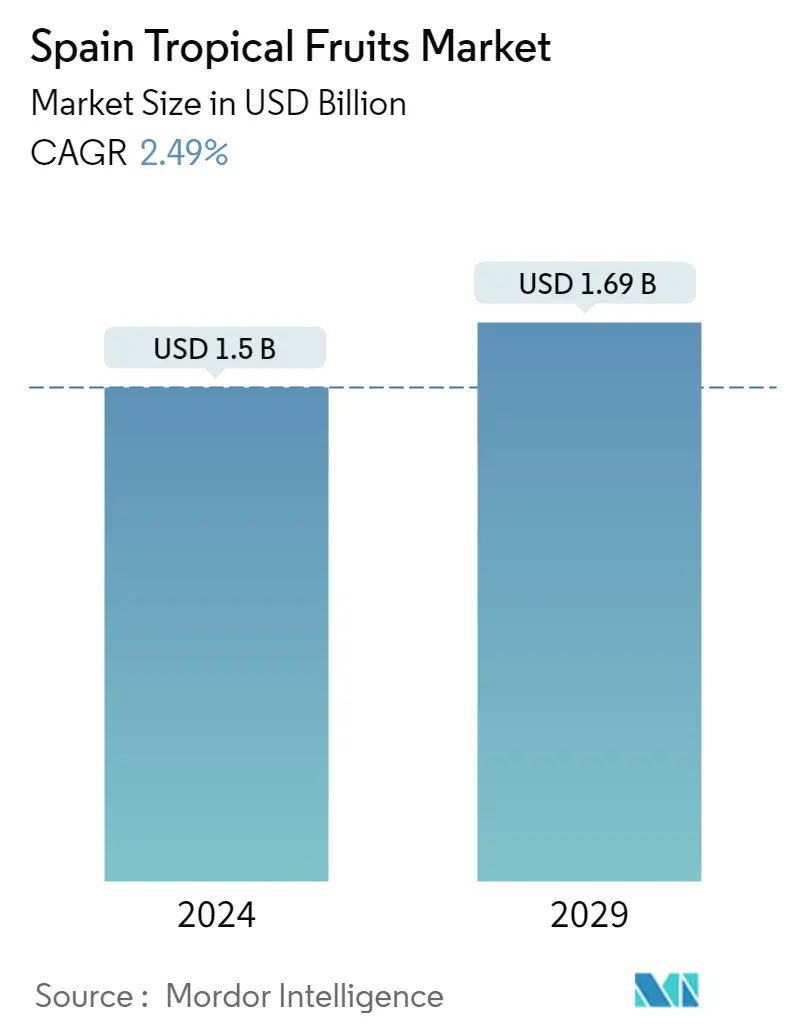Market Size of Spain Tropical Fruits Industry

| Study Period | 2019 - 2029 |
| Base Year For Estimation | 2023 |
| Forecast Data Period | 2024 - 2029 |
| Market Size (2024) | USD 1.50 Billion |
| Market Size (2029) | USD 1.69 Billion |
| CAGR (2024 - 2029) | 2.49 % |
Spain Tropical Fruits Market Analysis
The Spain Tropical Fruits Market size is estimated at USD 1.5 billion in 2024, and is expected to reach USD 1.69 billion by 2029, growing at a CAGR of 2.49% during the forecast period (2024-2029).
- Spain is a large producer of fresh fruit, and its dominant role in the fresh sector has resulted in increasing imports with a larger volume from non-European countries and has the potential to become a trade hub for fresh produce from non-European countries.
- Spain holds 40.1% of Europe's area of fruit cultivation and has the highest production share in Europe in oranges (54%), small citrus fruit (67%), avocados (91%), watermelon (35%), peaches (37%), peppers (48%) and lemons (65%). Spain is growing an appetite for less traditional fruit and vegetables, which increases the need for imported products.
- Avocados represent the highest value in the Spanish imports of fresh fruit from non-European suppliers, making the country more attractive for international trade and as an access point into Europe. Spain is advancing in well-structured logistics and expanding services and packaging solutions.
- Various agricultural policies have paved the way for the development of the fresh produce supply chain at all levels, as it is a vital component of the overall strategy for addressing global market competition for oranges. This enhances the performance and competitiveness of the countries on the import and export front. The increased disposable income and high spending capacity on health and related products enable fresh produce sales in developed regions such as Europe and North America. In 2021, Egypt exported approximately 300,000 tons to EU countries, consolidating its position as the leading non-EU supplier in the Mediterranean, in direct competition with Spain.
- Thus, the factors such as increased demand from processing industries, increasing awareness of the health benefits of fruits, growing consciousness of health, and increasing incomes of consumers are propelling the growth of the market studied during the forecast period.
Spain Tropical Fruits Industry Segmentation
Tropical fruits are a botanically diverse group of fruit indigenous to tropical regions in the country, such as mango, papaya, pineapple, banana, and many others. The market is analyzed for fresh fruits, and processed form is excluded from the study.
The report provides an in-depth analysis of various parameters of the Spanish tropical fruits market. The report includes a production analysis (volume), consumption analysis (volume and value), import analysis (volume and value), export analysis (volume and value), and price analysis of the tropical fruits market in the country. The fruits covered in the report are Dragon fruit, Banana, Avocado, Watermelon, and other fruit types. The report offers market size and forecasts in terms of value (USD thousand) and volume (metric ton) for all the above segments.
Spain Tropical Fruits Market Size Summary
The Spanish tropical fruits market is poised for steady growth, driven by Spain's strategic position as a significant producer of fresh fruit and its expanding role as a trade hub for non-European fresh produce. With a substantial portion of Europe's fruit cultivation area, Spain leads in the production of various fruits, including oranges, avocados, and lemons. The country's increasing appetite for less traditional fruits and vegetables has spurred a rise in imports, particularly avocados, enhancing its attractiveness for international trade. This growth is supported by well-structured logistics, expanded services, and packaging solutions, which are crucial for maintaining competitiveness in the global market. Agricultural policies have further bolstered the fresh produce supply chain, enabling Spain to strengthen its import and export capabilities.
The market's expansion is also fueled by rising consumer awareness of the health benefits of fruits, increased disposable incomes, and a shift towards healthier diets in developed regions. Government initiatives in developing countries to promote consumer health have positively impacted the demand for fruits like mangoes, avocados, and blueberries. The urban population's growing awareness of food origins and quality has led to increased supply of high-quality products through various distribution channels. Additionally, the cultivation of resilient fruits like dragon fruit, which can thrive in diverse climatic conditions, is gaining popularity, contributing to market growth. The market is further supported by strategic partnerships and campaigns aimed at promoting tropical fruit consumption, such as those by SanLucar and Trops, which enhance domestic production and consumption in Spain.
Spain Tropical Fruits Market Size - Table of Contents
-
1. MARKET DYNAMICS
-
1.1 Market Overview
-
1.2 Market Drivers
-
1.3 Market Restraints
-
1.4 Value Chain Analysis
-
-
2. MARKET SEGMENTATION
-
2.1 Production Analysis (Volume)
-
2.2 Consumption Analysis (Value and Volume)
-
2.3 Import Analysis (Value and Volume)
-
2.4 Export Analysis (Value and Volume)
-
2.5 Price Trend Analysis
-
Spain Tropical Fruits Market Size FAQs
How big is the Spain Tropical Fruits Market?
The Spain Tropical Fruits Market size is expected to reach USD 1.50 billion in 2024 and grow at a CAGR of 2.49% to reach USD 1.69 billion by 2029.
What is the current Spain Tropical Fruits Market size?
In 2024, the Spain Tropical Fruits Market size is expected to reach USD 1.50 billion.

